Początkujący często pytają nas o przejście na SSL lub HTTPS. Terminy te mogą brzmieć zbyt technicznie, ale w rzeczywistości jest to bardzo proste.
HTTPS w adresie URL strony internetowej oznacza, że korzysta ona z bezpiecznego protokołu przesyłania danych poprzez zainstalowanie certyfikatu SSL. Jest to ważne, ponieważ większość nowoczesnych przeglądarek wyświetla ostrzeżenia dla witryn, które nie używają protokołu HTTPS.
Na szczęście większość niezawodnych firm hostingowych i WordPress bardzo ułatwiają zabezpieczenie witryny.
W tym artykule pokażemy, jak przenieść WordPress z HTTP na HTTPS poprzez dodanie certyfikatu SSL. Nie martw się, jeśli nie wiesz, czym jest SSL lub HTTPS. Wyjaśnimy to również.
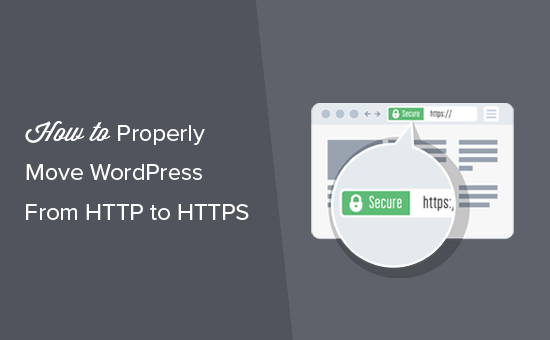
Oto krótki przegląd tematów, które omówimy w tym artykule:
- What Is HTTPS?
- Why Do You Need HTTPS and SSL?
- Requirements for Using HTTPS/SSL on a WordPress Site
- Setting Up WordPress to Use SSL and HTTPS
- Method 1: Setup SSL/HTTPS in WordPress Using a Plugin
- Method 2: Set Up SSL/HTTPS in WordPress Manually
- Submit Your HTTPS Site to Google Search Console
- Bonus Resources
- Video Tutorial
Co to jest HTTPS?
HTTPS lub Secure HTTP to metoda szyfrowania, która zabezpiecza połączenie między przeglądarką użytkownika a serwerem. To dodatkowe zabezpieczenie znacznie utrudnia hakerom przechwycenie przesyłanych danych.
Każdego dnia ludzie dzielą się danymi osobowymi z witrynami internetowymi, niezależnie od tego, czy dokonują zakupów, czy po prostu logują się. Widzieliśmy na własne oczy, jak ważna jest ochrona tego rodzaju wymiany danych.
Aby zapewnić bezpieczeństwo danych, należy ustanowić bezpieczne połączenie.
W tym miejscu do gry wkraczają SSL i HTTPS.
Każda witryna otrzymuje unikalny certyfikat SSL w celu identyfikacji. Jeśli serwer próbuje użyć protokołu HTTPS bez ważnego certyfikatu lub jeśli certyfikat nie jest zgodny, większość nowoczesnych przeglądarek ostrzega użytkowników i odradza im kontynuowanie.
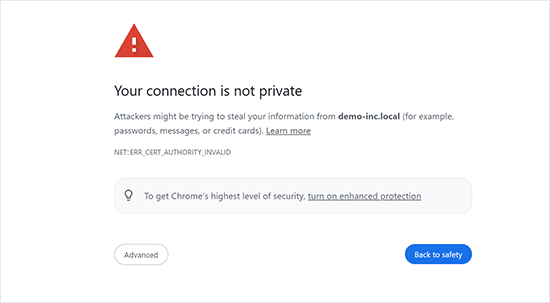
Teraz możesz się zastanawiać, dlaczego przeniesienie witryny WordPress z HTTP na HTTPS jest konieczne, zwłaszcza jeśli jest to prosty blog lub witryna małej firmy, która nie przetwarza płatności.
Dlaczego potrzebujesz HTTPS i SSL?
W 2018 roku Google ogłosiło inicjatywę mającą na celu zwiększenie bezpieczeństwa w sieci poprzez zachęcanie właścicieli witryn do przejścia z protokołu HTTP na HTTPS. W ramach obsługi tego ruchu przeglądarka Chrome zaczęła oznaczać wszystkie witryny bez certyfikatu SSL jako “Niezabezpieczone”.
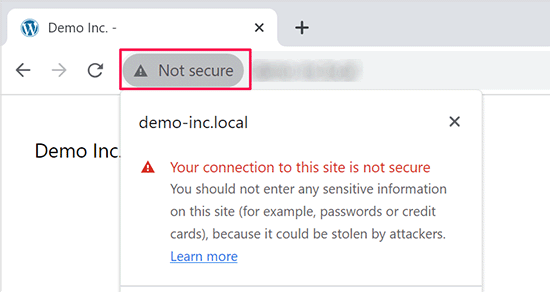
Google wspomniało również, że witryny z SSL otrzymają korzyści SEO i mogą osiągnąć wyższe rankingi wyszukiwania niż witryny niezabezpieczone. To ogłoszenie skłoniło wielu właścicieli witryn do przejścia na HTTPS.
Po wprowadzeniu ostrzeżenia “Niezabezpieczone” Chrome zaczął oznaczać witryny HTTP. Na przykład odwiedzenie witryny HTTP w trybie incognito lub wypełnienie formularza kontaktowego w witrynie HTTP uruchamia ostrzeżenie, oznaczając ją jako niezabezpieczoną.
Gdy odwiedzający zobaczą to ostrzeżenie, może to pozostawić negatywne wrażenie na temat witryny lub firmy.
Dlatego wszystkie strony internetowe muszą jak najszybciej przejść na HTTPS i zainstalować SSL.
Co więcej, SSL jest koniecznością, jeśli chcesz akceptować płatności online na swojej stronie e-handlu.
Dostawcy płatności tacy jak Stripe, PayPal Pro i Authorize.Net wymagają bezpiecznego połączenia płatniczego.
Zapewniamy, że nasze własne witryny używają SSL, w tym WPBeginner, OptinMonster, WPForms i MonsterInsights.
Wymagania dotyczące korzystania z HTTPS/SSL na witrynie WordPress
Wymagania dotyczące korzystania z SSL w WordPress nie są zbyt wysokie. Wszystko, co musisz zrobić, to kupić certyfikat SSL, a być może masz go już za darmo.
Najlepsze firmy hostingowe WordPress oferują darmowe certyfikaty SSL dla wszystkich swoich użytkowników:
Więcej szczegółów można znaleźć w naszym przewodniku na temat tego, jak uzyskać bezpłatny certyfikat SSL dla twojej witryny internetowej WordPress.
Jeśli Twoja firma hostingowa nie oferuje bezpłatnego certyfikatu SSL, musisz go zakupić.
Polecamy Domain.com, ponieważ oferuje najlepszą ofertę SSL dla zwykłych i wieloznacznych certyfikatów SSL.
Kupując u nich certyfikat SSL, otrzymujesz również pieczęć TrustLogo dla swojej witryny. Każdy certyfikat SSL objęty jest minimalną gwarancją bezpieczeństwa w wysokości 10 000 USD. Ceny zaczynają się od 33 USD rocznie, a certyfikaty SSL są odnaw iane automatycznie.
Po zakupie certyfikatu SSL należy poprosić dostawcę hostingu o jego zainstalowanie.
Potrzebujesz pomocy w konfiguracji SSL i przejściu na HTTPS?
Jeśli nie masz czasu na konfigurację SSL, nasza usługawsparcia Premium WordPress jest tutaj, aby pomóc! Możemy zająć się całym procesem za Ciebie, zapewniając, że Twoja witryna jest bezpieczna i gotowa dla odwiedzających.
- Opłata jednorazowa
- Szybki czas realizacji
- Dostępne na żądanie 24/7
Możesz spać spokojnie wiedząc, że Twoja witryna jest w rękach ekspertów. Skontaktuj się z nami już dziś, aby uzyskać bezproblemową instalację SSL i migrację HTTPS!
Konfiguracja WordPressa do korzystania z SSL i HTTPS
Po włączeniu certyfikatu SSL dla twojej domeny, będziesz musiał skonfigurować WordPressa tak, aby używał protokołów SSL i HTTP na twojej witrynie internetowej.
Pokażemy ci dwie metody, aby to zrobić i możesz wybrać tę, która najlepiej odpowiada twoim potrzebom.
Metoda 1: Konfiguracja SSL/HTTPS w WordPress przy użyciu wtyczki
Ta metoda jest łatwiejsza i zalecana dla początkujących.
Najpierw należy zainstalować i włączyć wtyczkę Really Simple SSL. Aby uzyskać więcej informacji, zobacz nasz przewodnik krok po kroku, jak zainstalować wtyczkę WordPress.
Po aktywacji należy odwiedzić stronę Ustawienia ” SSL. Wtyczka automatycznie wykryje certyfikat SSL i skonfiguruje witrynę WordPress do korzystania z protokołu HTTPS.
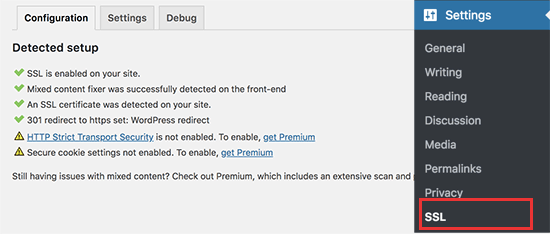
Wtyczka zajmie się wszystkim, w tym błędami związanymi z mieszaną treścią. Oto, co wtyczka robi za kulisami:
- Sprawdź certyfikat SSL
- Ustawienie WordPressa tak, by używał https w adresach URL
- Konfiguracjaprzekierowań z HTTP na HTTPS
- Poszukaj adresów URL w treści, które nadal są ładowane z niezabezpieczonych źródeł HTTP i spróbuj je poprawić.
Uwaga: Wtyczka próbuje poprawić błędy mieszanej zawartości przy użyciu techniki buforowania wyjściowego. Może to mieć negatywny wpływ na wydajność, ponieważ zastępuje zawartość witryny podczas ładowania strony. Wpływ ten jest widoczny tylko przy pierwszym ładowaniu strony i powinien być minimalny, jeśli używasz wtyczki buforującej.
Chociaż wtyczka mówi, że możesz zachować SSL i bezpiecznie wyłączać wtyczkę, nie jest to w 100% prawdą. Będziesz musiał pozostawić wtyczkę aktywną przez cały czas, ponieważ wyłączanie wtyczki spowoduje powrót błędów mieszanej treści. Więcej szczegółów można znaleźć w naszej recenzji Really Simple SSL.
Metoda 2: Ręczna konfiguracja SSL/HTTPS w WordPress
Ta metoda wymaga ręcznego rozwiązywania problemów i edytowania plików WordPress. Jest to jednak trwałe i bardziej zoptymalizowane pod kątem wydajności rozwiązanie, z którego korzystamy na WPBeginner.
Jeśli uważasz, że ta metoda jest trudna, powinieneś zatrudnić programistę WordPress lub skorzystać z pierwszej metody.
W ramach tej metody może być konieczna edycja motywu WordPress i plików kodu. Jeśli nie robiłeś tego wcześniej, zapoznaj się z naszym przewodnikiem na temat kopiowania i wklejania fragmentów kodu w WordPress.
Najpierw musisz odwiedzić stronę Ustawienia ” Ogólne. W tym miejscu należy zaktualizować pola adresu URL WordPress i witryny, zastępując http na https.
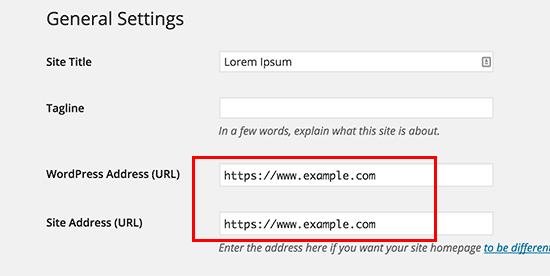
Nie zapomnij kliknąć przycisku “Zapisz zmiany”, aby zapisać twoje ustawienia.
Po zapisaniu ustawień WordPress wyloguje cię i zostaniesz poproszony o ponowne zalogowanie.
Następnie musisz skonfigurować przekierowania WordPress z HTTP na HTTPS, dodając następujący kod do twojego pliku .htaccess:
1 2 3 4 5 | <IfModule mod_rewrite.c>RewriteEngine OnRewriteCond %{HTTPS} offRewriteRule ^(.*)$ https://%{HTTP_HOST}%{REQUEST_URI} [L,R=301]</IfModule> |
Jeśli korzystasz z serwerów NGINX, będziesz musiał dodać następujący kod, aby przekierować z HTTP na HTTPS w twoim pliku konfiguracyjnym:
1 2 3 4 5 | server {listen 80;server_name example.com www.example.com;return 301 https://example.com$request_uri;} |
Nie zapomnij zastąpić example.com nazwą twojej domeny.
Wykonując te kroki, unikniesz błędu WordPress HTTPS nie działa, ponieważ WordPress będzie teraz wczytywać całą twoją witrynę internetową za pomocą HTTPS.
Jeśli chcesz wymusić SSL i HTTPS na twoim obszarze administracyjnym WordPress lub stronach logowania, musisz skonfigurować SSL w pliku wp-config.php.
Dodaj następujący kod nad linią “To wszystko, przestań edytować!” w twoim pliku wp-config.php:
1 | define('FORCE_SSL_ADMIN', true); |
Ta linia pozwala WordPressowi wymusić SSL / HTTP w obszarze administracyjnym WordPress. Działa również w sieciach witryn WordPress.
Gdy to zrobisz, twoja witryna internetowa jest w pełni skonfigurowana do korzystania z SSL / HTTPS, ale nadal będziesz napotykać błędy mieszanej treści.
Błędy te są powodowane przez źródła (obrazki, skrypty lub arkusze stylów), które nadal są wczytywane przy użyciu niezabezpieczonego protokołu HTTP w adresach URL. W takim przypadku na pasku adresu twojej witryny internetowej nie będzie widoczna ikonka zabezpieczenia w postaci kłódki.
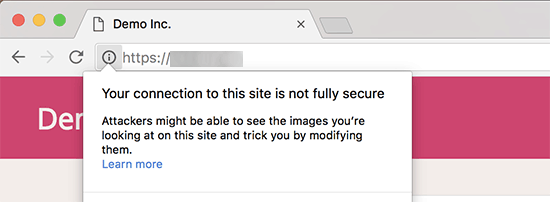
Wiele nowoczesnych przeglądarek automatycznie blokuje niebezpieczne skrypty i zasoby.
Możesz zobaczyć ikonkę kłódki, ale z powiadomieniem o tym w pasku adresu twojej przeglądarki.
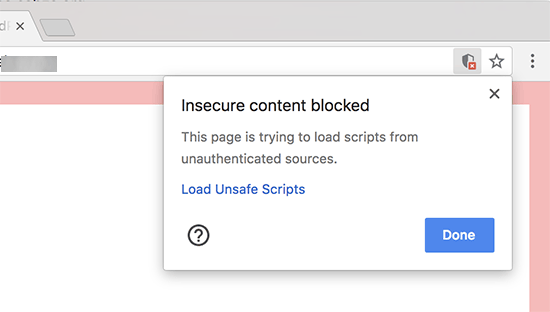
Za pomocą narzędzia Inspect można sprawdzić, które treści są serwowane za pośrednictwem niezabezpieczonego protokołu.
Błąd mieszanej treści zostanie wyświetlony jako ostrzeżenie w konsoli ze szczegółowymi informacjami dla każdego elementu mieszanej treści.
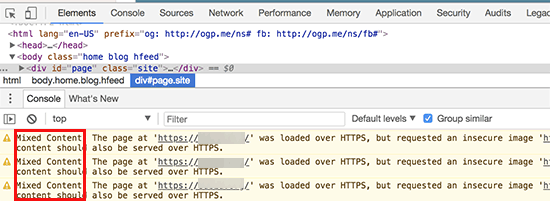
Zauważysz, że większość adresów URL to obrazki, ramki iframe i galerie obrazów, podczas gdy niektóre to skrypty i arkusze stylów wczytywane przez twoje wtyczki i motywy WordPress.
Poprawka mieszanych treści w bazie danych WordPressa
Większość nieprawidłowych adresów URL to obrazy, pliki, elementy osadzone i inne dane przechowywane w bazie danych WordPress. Poprawmy je w pierwszej kolejności.
Najlepiej byłoby znaleźć wszystkie wzmianki o adresie URL starej witryny w bazie danych, które zaczynają się od HTTP i zastąpić je nowym adresem URL witryny, który zaczyna się od HTTPS.
Możesz to łatwo zrobić, instalując i włączając wtyczkę Search & Replace Everything. Aby uzyskać więcej informacji, zapoznaj się z naszym przewodnikiem krok po kroku, jak zainstalować wtyczkę WordPress.
Po włączaniu należy przejść na stronę Narzędzia ” WP Wyszukaj i zamień. W polu “Szukaj” należy dodać adres URL Twojej witryny internetowej z http. Następnie w polu “Zamień” dodaj adres URL Twojej witryny internetowej z https.
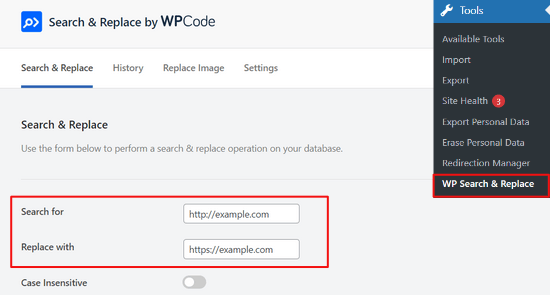
Poniżej znajdują się wszystkie tabele bazy danych WordPress.
Musisz wybrać wszystkie z nich, aby przeprowadzić dokładną kontrolę.
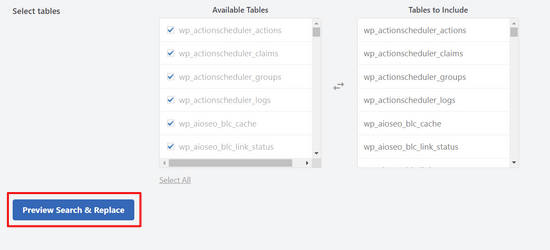
Następnie kliknij przycisk “Podgląd wyszukiwania i zamiany”, aby zobaczyć wszystkie zmiany wprowadzone przez wtyczkę.
Na koniec kliknij przycisk “Zamień wszystko”.
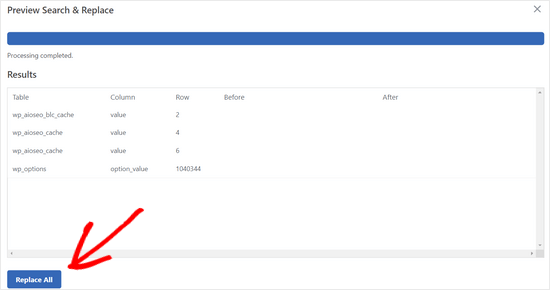
Wtyczka przeszuka teraz twoją bazę danych WordPress pod kątem adresów URL zaczynających się od http i zastąpi je bezpiecznymi adresami URL https. Może to chwilę potrwać, w zależności od rozmiaru twojej bazy danych WordPress.
Poprawka błędów mieszanych treści w motywie WordPress
Innym częstym winowajcą powodującym błędy mieszania treści jest twój motyw WordPress. Każdy przyzwoity motyw WordPress zgodny ze standardami kodowania WordPress nie spowoduje tego problemu.
Po pierwsze, będziesz musiał użyć narzędzia Inspect twojej przeglądarki, aby znaleźć zasoby i miejsce, z którego są wczytywane.
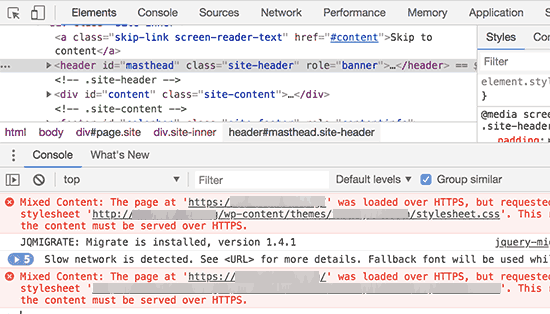
Następnie musisz znaleźć je w twoim motywie WordPress i zastąpić je https. Będzie to trochę trudne dla większości początkujących, ponieważ nie będziesz w stanie zobaczyć, które pliki motywu zawierają te adresy URL.
Poprawka błędów mieszanych treści spowodowanych przez wtyczki
Niektóre zasoby o mieszanej treści będą wczytywane przez wtyczki WordPress. Każda wtyczka WordPress zgodna ze standardami kodowania WordPress nie spowoduje błędów mieszanej treści.
Nie zalecamy edytowania plików wtyczek WordPress. Zamiast tego należy skontaktować się z autorem wtyczki i poinformować go o tym. Jeśli nie odpowiedzą lub nie będą w stanie tego poprawić, powinieneś znaleźć odpowiednią alternatywę.
Uwaga: Jeśli z jakiegoś powodu nadal napotykasz błąd mieszanej treści, zalecamy tymczasowe korzystanie z wtyczki Really Simple SSL, aby nie wpływać na użytkowników, podczas gdy poprawisz problem na witrynie przejściowej lub zatrudnisz programistę.
Prześlij swoją witrynę HTTPS do Google Search Console
Wyszukiwarki takie jak Google uważają https i http za dwie różne witryny internetowe. Aby uniknąć problemów z SEO, musisz poinformować Google, że Twoja witryna internetowa została przeniesiona.
Aby to zrobić, wystarczy przejść do konta Google Search Console i kliknąć przycisk “Dodaj właściwość”.

Spowoduje to wyświetlenie wyskakującego okienka, w którym należy utworzyć nowy adres https twojej witryny internetowej.
Istnieją dwie metody weryfikacji witryny: nazwa domeny lub prefiks adresu URL. Zalecamy metodę prefiksu adresu URL, ponieważ jest ona bardziej elastyczna.
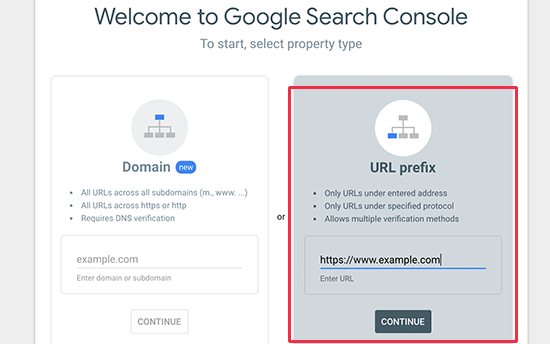
Następnie Google poprosi Cię o zweryfikowanie własności Twojej witryny internetowej.
Można to zrobić na kilka sposobów. Wybierz dowolną metodę, a otrzymasz instrukcje dotyczące weryfikacji twojej witryny. Zalecamy skorzystanie z metody tagów HTML.
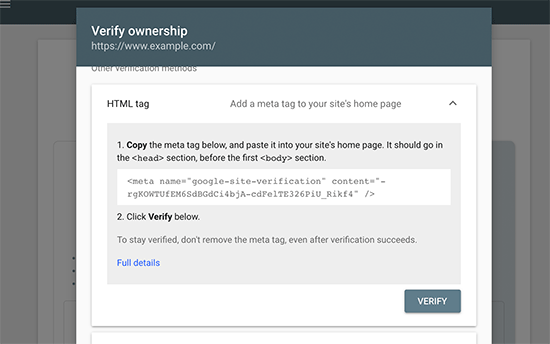
Zobaczysz teraz fragment kodu HTML, który musisz dodać do sekcji head twojej witryny internetowej WordPress.
Dodawanie kodu weryfikacyjnego Search Console za pomocą All in One SEO
Najpierw zainstaluj i włącz wtyczkę All in One SEO for WordPress. Aby uzyskać więcej informacji, zapoznaj się z naszym poradnikiem na temat instalacji wtyczki WordPress.
Uwaga: Istnieje również darmowa wersja All in One SEO, którą można wypróbować.
Po włączaniu przejdź do strony All in One SEO ” Ustawienia ogólne i kliknij Google Search Console.
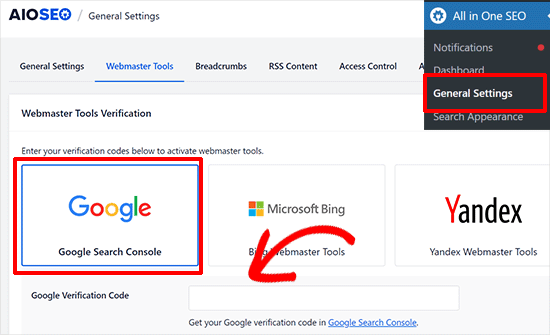
Poniżej należy dodać kod weryfikacyjny skopiowany wcześniej z witryny internetowej Google Search Console.
Nie zapomnij kliknąć przycisku “Zapisz zmiany”, aby zapisać twoje ustawienia.
Następnie przełącz się z powrotem na kartę Google Search Console i kliknij przycisk “Weryfikuj”.
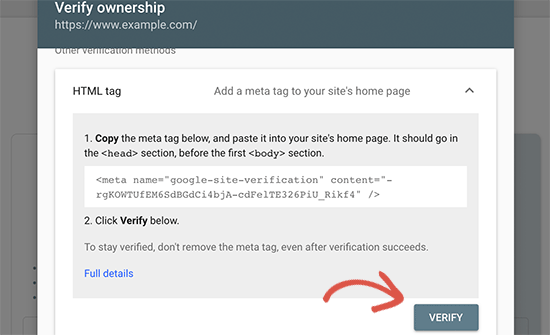
Gdy twoja witryna zostanie zweryfikowana, Google wyświetli tutaj raporty Search Console.
Musisz również upewnić się, że zarówno wersja https, jak i http są dodane do twojej Search Console.
W ten sposób informujesz Google, że chcesz, aby wersja https Twojej witryny była traktowana jako wersja podstawowa. W połączeniu z przekierowaniami 301 skonfigurowanymi wcześniej, Google przeniesie rankingi wyszukiwania do wersji https Twojej witryny i najprawdopodobniej zobaczysz poprawę w rankingach wyszukiwania.
Zasoby bonusowe
Poniżej znajduje się kilka dodatkowych zasobów, które mogą pomóc w samodzielnej poprawie typowych problemów z WordPressem i dowiedzieć się więcej o WordPressie:
- Jak naprawić typowe problemy z SSL w WordPress (przewodnik dla początkujących)
- Najczęstsze błędy WordPressa i sposoby ich poprawki
- TLS vs SSL: Którego protokołu należy używać w WordPress?
- Jak naprawiono błąd bezpiecznego połączenia w WordPress?
Film instruktażowy
Mamy nadzieję, że ten artykuł pomógł Ci dodać HTTPS i SSL w WordPress. Możesz również zapoznać się z naszym kompletnym przewodnikiem bezpieczeństwa WordPress z instrukcjami krok po kroku, jak zapewnić bezpieczeństwo witryny WordPress lub jak odnowić certyfikat SSL.
If you liked this article, then please subscribe to our YouTube Channel for WordPress video tutorials. You can also find us on Twitter and Facebook.





Weslry
This article is a little bit trap for newbie because if you first change to https in your wp panel and then try to add those codelines to right files you can’t reach your webiste or wp admin panel. (443 error) I had to edit files through ftp and made myself fool at work for making such a mistake. So first you have to get the certificates and edit htaccess file etcetc and then add that S in your wp admin panel (or directly edit thorugh ftp).
Daryl
Thanks for heads up ! good article
Huseyn
Hi! Thank you for this article. Very useful!
But I was faced with one problem. After installing SSL (I use free version of Cloudflare SSL) I cannot edit any pages/posts/products. Does anybody face with such problem? And how did you solve it?
Thanks in advance!
Michael Penner
Thank you for the excellent and easy to understand article about WordPress and SSL. I was pleasantly surprised to see it was from one of my favorite plugin authors. Cheers!
WPBeginner Support
Hi Michael,
Glad you found it helpful
Admin
Maurizio Mau
Hi and many thanks for post,
i have implemented SSL, run good on all bowser included mobile, load in 1.5 sec, console upgraded, analitucs upgraded, redirect done, fixed all element but ranking drop approx 20% and above…
Onis Egwu
Hello There,
Wonderful article. The issue I have with using the .htaccess file to route through https is that whenever WordPress updates, it cleans off the edits done.
Is there a way to avoid this?
max
hi there,
i saw your post and is interesting..but i can’t understand one thing… I read you article and i made all about it … in admin area is ok all is https..
but the front end no .. i mean when i see the site with chrome the padlock appear and then disappear ???!??!?!
any ideas?
Hardy
I am having the same issue. :/
Swapan Kumar Manna
Hello,
I’ve purchased an SSL certificate form Godaddy and it is approved and downloaded the .crt file. I’m bit confused what are the next steps to install the file in the server and how to redirect all the URLs in the existing WordPress site. Can anyone give me the detailed guide step by step.
Also requesting WPBeginer to write an article on this topic “How to install SSL certificate in Godaddy.
Thanks.
Cathy Larkin
did you fix your issue? I am getting ready to do this. I thought GD did it for you?
Rohit
Hi, as you said I went to my wordpress blog settings page and changed my domain url to https from http and clicked save however Now I am not able to login to my wordpress dashboard and getting 404 error.
How can I solve this please becuase I cannot even login to my wordpress dashboard to change it back to http again
Abhay
Hello sir, I want to know why you are not using https on wpbeginner?
WPBeginner Support
Hi Abhay,
We don’t use HTTPS because we don’t collect any secure data. We do plan to change as our needs will change in the near future.
Admin
Pat B
Fantastically clear and helpful instructions. Many thanks!
Brody James
Hi,
This worked great after following your steps. However, I notice that a few pages i.e. contact page does not display the green SSL lock but still displays https://
How do I fix this?
Thanks
BJ
Vaggelis
That really rocked!!! Thank you so much. The https rocks


Esther
Thanks so much for this.
Amin
all SSL redirections have problems with cookies didn’t found a solution from a year now. can someone help ? plz ? there is a big problem on auth cookies .. and got redirect to reauth=1
there is no synch of cookies between front and backend , and authors get disconnected when they upload files .. I think it’s related to root/wp-load.php and /wp-admin/async-apload.php
Amritosh Pandey
Please try this –
# BEGIN WordPressRewriteEngine On
RewriteCond %{SERVER_PORT} !^443$
RewriteRule (.*) https://{HTTP_HOST}%{REQUEST_URI} [R=301,L]
RewriteBase /
RewriteRule ^index\.php$ - [L]
RewriteCond %{REQUEST_FILENAME} !-f
RewriteCond %{REQUEST_FILENAME} !-d
RewriteRule . /index.php [L]
# END WordPressJoe
This Worked for me in my .htaccess file, all I needed to do was to change the port to “80”
The htaccess snippet in the post just refused to work.
thanks for this.
Amy
Hi, just wanted to let you know I added Let’s Encrypt to my site and changed it in my WordPress dashboard it automagically updated the LOGIN page. I didn’t need to add the code to the wpconfig.php file.
I wonder if this is a new addition to WordPress?
Meenakshi
Hi,
I recently moved my WP site from WP’s free hosting to another hosting site, the issue I’m facing is with SSL. Any help from here is appreciated?
Daniel
What issues are you having?
sujith
Hi , after converting to https i am getting error like
“You do not have sufficient permissions to access this page” in wp-admin
Not able to access wp-admin.
When i revert the changes its working fine.
Can anybody please help
Bruce
My website is redirecting under
https to a different website and I cannot find where the redirect is.
Any ideas as to where to look would be appreciated.
I have tested the plugins by disabling them.
I have tested the themes by changing themes.
I have looked at the htaccess.
All works well except under https where it redirects to one of my other sites.
Any help appreciated.
Rrich
Hi,
I changed the wordpress and site address at the General settings tab at wordpress from http to https. And I can’t access my site again.
I now get your site is insecure when Ii type in he url.
I can’t even access the admin.
Please help
Karl D.
Don’t know if you got this fixed, but you can go into mysql (phpMyAdmin) and look for the table wp-options. There you will find a table entry titled “siteurl” and one titled “home” you can remove the s from https in the url there and your site will come back. I would make sure that you have the .htaccess and wp-config edited like stated in this article first and upload them to your site first and check if things work from there. If not, reset the .htaccess and wp-config file and edit the mysql like stated above and your site will come back when accessed without the https.
Good luck!
Best,
Karl D.
Kalle
Thanks Karl ! This worked ! I just edited the files in (phpMyAdmin) !
So if you mess with http / https settings with your wP try this !
I tried to edit my .httaccess file for 2-3 hours…..
Moty
After activation and change force admin ti https can’t login- Page Not found 401
can you please let me know how can I revert the changes?
thanks
Moty
I have erased the plugin via file manager,
Now can login to my wp admin but still can’t get into the plugins panel VIA Wp ,
it is asking for an https address
Please help
Thanks
Naeem Hussain
Dear Sir WPbeginner,
I installed SSL + dedicated IP Certificate to my Wp Website name computerpakistan.com. Now its everything working fine, But problem with my website page speed.
Before SSL Speed
1.8 seconds
After SSL Installation site page Speed
4.3 Secondes by gtmatrix report
Ritesh
I am not able to access the admin area after I uploaded define(‘FORCE_SSL_ADMIN’, true); to wp-config.php. My site was already using wordpress https plugin with force ssl administration checked in. I removed that plugin using ftp but I am still not able to login. It says incorrect username or password. However neither the password nor the username has been changed. I think this was the problem after I tried adding define(‘FORCE_SSL_ADMIN’, true); to wp-config.php. I can see the login page on https version of the site but not able to login. Please guide further.
Ritesh
Its absolutely blank page and nothing else.
The Platypus
I’m hopeful you ran a back up before doing any changes to your site.. in either case revert back your site to an earlier state via your database, and whatever back up of your config.php file you have.
Florin
I’m having the same problem. I checked everything but I still cannot login in my admin area.
Stephen
I had a similar problem after enabling FORCE_SSL_ADMIN in wp-config.php.
The login page etc. was coming up ok over HTTPS but it wouldn’t let me login successfully.
In this case, it was a plugin interfering – “Chap Secure Password Login”. After deactivating it, logins worked ok (and in fact, it’s not needed when WordPress is configured to force SSL on the admin page).
So I would suggest checking any login related plugins and try deactivating them.
Another issue is if you are using something like HAProxy in front of your webserver for load balancing, and get something like a “too many redirects” error message after trying to move WordPress to HTTPS.
In this case, you most likely need to modify wp-config.php to tell WordPress that the connection is actually HTTPS, otherwise it will keep trying to redirect even when the client connection is over HTTPS. There are some details here,
Monu
Hello sir I am using wordpress with https and www ……………….. in my site everthing is okay url of posts and pages are also use https but in google search results not show https in my website address only show http://www.example.com/post...
WPBeginner Support
You will need to inform Google about change of address from Google Webmaster Tools.
Admin
Raivat
Hi, I followed your tutorial. Thanks, Everything works! But I am getting an error when I load the home page saying “Your connection to this site is private, but someone on the network might be able to change the look of the page”. I checked it out and it seems there is a problem in one of my font resources which uses Google Fonts with http instead https, can you show me how can I fix this?
Thanks
Sebastian
Try removing the “http://” from the Google Font call. So it’s not being forced across HTTPS. The reference call to the Google Font link should start with the “www.” instead of “http://”
Naval Gupta
Should we use 301 redirect to redirect all http pages to https pages?
Mark Cohen
Everything working fine, except that when on Dashboard > Home I get exclamation mark across padlock in URL bar. Anyone know what content is being served insecurely on this page?
Joel
I made the changes in the site before I set up the certificate and now can not access the back end of my site.
David gillies
Hi followed your example and now cant access the website at all
if I try
all I get is jumbled page with no styling
WPBeginner Support
Instead of WordPress HTTPS SSL, please try Really Simple SSL plugin.
Admin
Adrienne
I need to do this soon for my nonprofit site, and I’m scared! Paying for this is going to be extra too, but I have to do it!. Thanks for this info….
Paying for this is going to be extra too, but I have to do it!. Thanks for this info….
Lourdes
So this comes up when I google my Blog Page. Using Bluehost/wordpress – DOES THIS MEAN O need to fix the SSL Cert issue aka buy from bluehost? Thank you!!!!
[We didn’t find any SSL certificate present on the website which is bad for users privacy. The site has a title but meta description is absent, it will be better for SEO if both are present. Homepage is in English.]
Maxim
Thanks for this post! Helped a lot!
Penny
What if you have Mixed Content going on and were asked to fix that before you proceed with installing SSL?
My Firewall, Sucuri said that I need to fix the mixed content before they can install the SSL. Now I’m stuck and do not know how to proceed. I’m nervous with installing plugins. They recommended really-simple-ssl plugin. Have you had any experience with this? I try to limit the using plugins…
Milon
Thanks BRO
Jarred
We installed the plugin WordPress HTTPS (SSL). We chose to only use SSL on specific pages option and everything is working great. However we have two important questions that came about after reading the GOOGLE article about migrating to https. Not sure if I can share link on here, so this is the title “Secure your site with HTTPS” on support google.
Questions.
1. Does the plugin WordPress HTTPS (SSL) automatically create 301 redirects to help search engines know we moved to https on those specific pages?
2. If the plugin does not create the 301 redirects, do WE need to go ahead and create the 301 redirects manually for those specific pages that we added SSL on? Thank you in advance
WPBeginner Support
See if the plugin is redirecting by checking it with an online redirect checker tool. If it isn’t, then you can setup your own redirects.
Admin
Jarred
I followed your advice and found a redirect tool. We used it and realized that the WordPress HTTPS (SSL) plugin DID in Fact create 301 redirects automatically. Great review and tutorial on this blog post and everything is working great. Thanks
WPBeginner Support
Glad you found it helpful
adam vikar
For a multisite setup, is there a code we can use to force SSL on the main site and NOT a specific subdomain?
Michelle
I put the wrong info in the SSL host box and now I get a 404 error. I cannot get back to any of my pages to disable the plugin or to change the info in the SSL host box. Please advise….
Easiest solution - delete the plug-in
The easiest solution is to delete the plug-in.
Access the files on your server (If you are using cPanel, you can use ‘File Manager’
Browse to where the plug-ins are kept
/wp-content/plugins
Find the plug-in and delete it.
Hiep Pro
You can use ftp client to delete plugin folder on web dir.
Jithin Johny George
Hi,
Awesome step-by-step guide.
But the plugin you have mentioned,WordPress HTTPS (SSL) has not updated in years.
Is there any alternative for the plugin ?
Thank You
Penny
I was advised by my firewall company to use Really Simple SSL. I haven’t tried it yet but they highly recommend it.
Kris Gabriel
Fantastic guide, simple and usefull.
The only thing to worry about is that the redirects causes the page to slow a bit down.
Is implementing the code listed above into the .access file the first choice or is it better with just a plugin?
I´ve chosen both options, that means both a wordpress https plugin AND .access code.
Would you say that is benicial or not?
Kind regards
Kris
Mursaleen Kamal
Assalam Alaikum Sir: We Have Been Successfully Implement this Guide on Our Website But We Still Facing Redirect issue,
Our Website Is Accessing from Both URL
http and https
and How to Resolve Mix Content Issue?
WPBeginner Support
Try really simple SSL plugin.
Admin
Ahmed Muhi
Thank you so much it worked.
Ali
Hello,
Thank you for your guide. I add this code in my htaccess file
RewriteEngine On
RewriteCond %{SERVER_PORT} 80
RewriteRule ^(.*)$ https://www.yoursite.com/$1 [R,L]
but now it do not do 301 redirect it is doing 302 redirect.
Please tell me is it ok to do 302 redirect or not.
Regards
WPBeginner Support
A 301 redirect means that the page has permanently moved to a new location. A 302 redirect means that the move is only temporary. Search engines need to figure out whether to keep the old page, or replace it with the one found at the new location.
Admin
Ana
Thanks for the article, but I should definitely have read it before adding the SSL and https to WP. Total newbie but somehow managing a wordpress site..
Changed WP site address on the settings page from http to https after an update recommendation on my admin panel. But now I can’t access the website or admin page! All I get is a blank page with the message ERR_TIMED_OUT and site can’t be reached.
I realised I hadn’t activated the free SSL certificate that comes with our web hoster. Now I have done that and I’ve tried adding a WP SSL redirect (http to https) code to the .htaccess file as well. And tried adding define force_SSL_admin to wp-config.php, but nothing has changed and I don’t know how to undo or fix the issue. Any suggestions or experience in this issue would be very helpful!
WPBeginner Support
Try using Really Simple SSL plugin.
Admin
mirko
sorry, but…I did not understand the part of .htaccess files … Must I add code to my htaccess or mix with my file ?
my original file is the default wordpress file
# BEGIN WordPressRewriteEngine OnRewriteBase /RewriteRule ^index\.php$ - [L]RewriteCond %{REQUEST_FILENAME} !-fRewriteCond %{REQUEST_FILENAME} !-dRewriteRule . /index.php [L]#ENDWordPress1-click Use in WordPress
The New file is correct ?
# BEGIN WordPressRewriteEngine OnRewriteCond %{SERVER_PORT} 80RewriteRule ^(.*)$ https://www.yoursite.com/$1 [R,L]RewriteEngine OnRewriteBase /RewriteRule ^index\.php$ - [L]RewriteCond %{REQUEST_FILENAME} !-fRewriteCond %{REQUEST_FILENAME} !-dRewriteRule . /index.php [L]#ENDWordPress1-click Use in WordPress
Thank you, Mirko
WPBeginner Support
The new file redirects your users to HTTPS
Admin
Jim
I’m a little unclear what needs to be in the htaccess file to force SSL
This is my current htacess
g
after changing the url in general settings, all css styles are gone, and the wp-login page to change this setting is not showing because of to many redirects. be aware before using this tut, I have to back up.
WPBeginner Support
Please see our guide on how to fix too many redirects error in WordPress.
Admin
Mark C
Hi, what about if we’re using it only for the login.php page, where do we configure it?
christopher
Thank you for your article! I was wondering though, my website recently has suffered some problems with “too many redirects” error. I wonder if adding the .htaccess code you mentioned in the article for ssl redirect will make the problem worse? Some visitors to my website said they often see “this page isn’t redirecting properly” when they come to our website. Could it be that our customers are having trouble visiting our website because I don’t have that code in my .htaccess file?
Melvin
Hi! I was wondering if there’s a reason why you only want SSL on specific pages instead of the whole website? Could this be because of performance?
Ahmed
Hello Syed! Great tutorial. I just want to ask that when ssl error window appears in browsers. Whether its the time to login,shopping or everytime you visit specific websit….For example if I have a blog which don’t offer login or shopping whteher ssl certificate is required or not???
WPBeginner Support
It is not required, but will certainly give you plus points in search results.
Admin
Jaclyn Mamuzich
Hello,
For some reason our blog is not showing as https even though we have an ssl installed and I thought it was done before the migration but I could be wrong. I followed the steps in the article (greatly appreciated but for some reason when I complete all the steps, almost all of my styling disappears, specifically related to layout. Any suggestions?
but for some reason when I complete all the steps, almost all of my styling disappears, specifically related to layout. Any suggestions?
thanks!
Rob
As with JACLYN MAMUZICH. I have followed all the steps and when the site is viewed in https:// all the CSS has gone. Any suggestions?